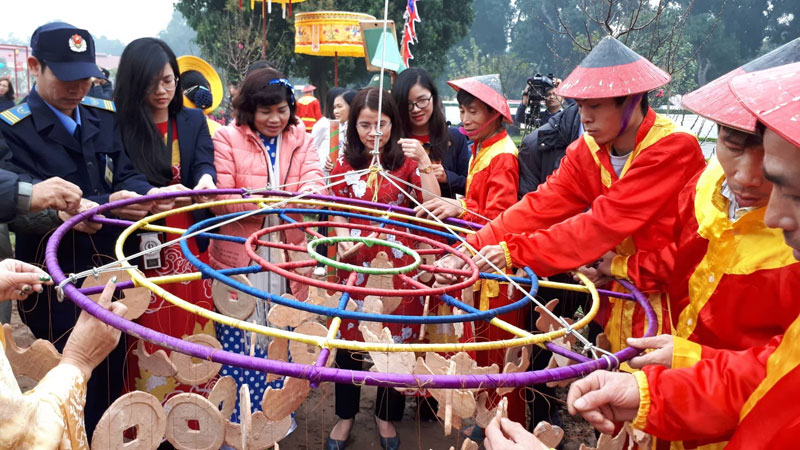
Traditional rituals to see off the old year and ring in the new year were performed at the Imperial Citadel of Thang Long, a UNESCO world heritage site, on January 26.

Decorating the Tet bamboo pole (Photo: Hoang Thanh Thang Long).
The activity kicked off a series of events to be held within the premises of the heritage site in order to welcome the year of the pig.
The event was attended by leaders of the Vietnamese Fatherland, the Ministry of Foreign Affairs, the Hanoi government, overseas Vietnamese and residents of the capital city.
The reproduced rituals included an offering to the Kitchen Gods, the release of carp into an ancient river at the archaeological site of 18 Hoang Dieu and the erection of a bamboo pole in front of the Doan Mon Gate.

A Tet bamboo pole is be put up at the imperial citdatel (Photo: Hoang Thanh Thang Long)
A delegation of overseas Vietnamese who will attend the Homeland Spring programme later in the day also offered incense at the imperial citadel.
To welcome the new year, an exhibition was held at 19C Hoang Dieu featuring cultural traditions that remind people of Tet in bygone days, while kids could experience folk games and enjoy exciting water puppetry performances.
According to the organisers, the re-enactment of the traditional rituals will help safeguard the traditional culture within the heritage site.
The Imperial Citadel of Thang Long will close during February 3-5 and reopen on February 6, or the second day of the Lunar New Year.
Source: NDO
Xoe dance, an unique art form of the Thai ethnic minority group in Mai Chau district of Hoa Binh province has existed for a long time and passed down through generations. Xoe dance is not only a popular dance in the Thai community but also a unique cultural feature, an indispensable part in the Thai ethnic minority people's cultural and spiritual life.
The Bac Son pre-school in Hung Son commune, Kim Boi district is effectively implementing a model of preserving and promoting cultural identity of the Muong ethnic group.
Through ups and downs, many unique cultural features of the Muong ethnic minority group are facing risks of falling into oblivion. However, with a strong determination, Lac Son district of Hoa Binh province has deployed synchronous solutions to preserve and promote the locality's cultural heritage values.
If Tan Lac is considered the core of the cradle of Muong culture in Hoa Binh, Phong Phu commune is the cultural centre of Muong culture in Tan Lac district. Luy Ai hamlet in Phong Phu commune is where customs and traditions of Muong Bi are preserved. Luy Ai hamlet was chosen to build a space to preserve Muong ethnic culture. The district is seeking support from the province and coordinating with relevant agencies to devise a plan on preservation of Muong cultural spaces associated with developing tourism products and improving the lives of local residents.
Nguyen Manh Tuan, a Muong ethnic man in Ba Hang Doi town, Lac Thuy district, is known as a young, dedicated, and outstanding artisan who has made significant contributions in collecting, restoring, and preserving national cultural values.
The Government Office with Document No. 2082/VPCP-KGVX, dated March 29, 2024, sent out the opinion of Deputy Prime Minister Tran Hong Ha regarding the submission of the "Mo Muong" and "Cheo art" dossiers to the United Nations Educational, Scientific and Cultural Organization (UNESCO).



